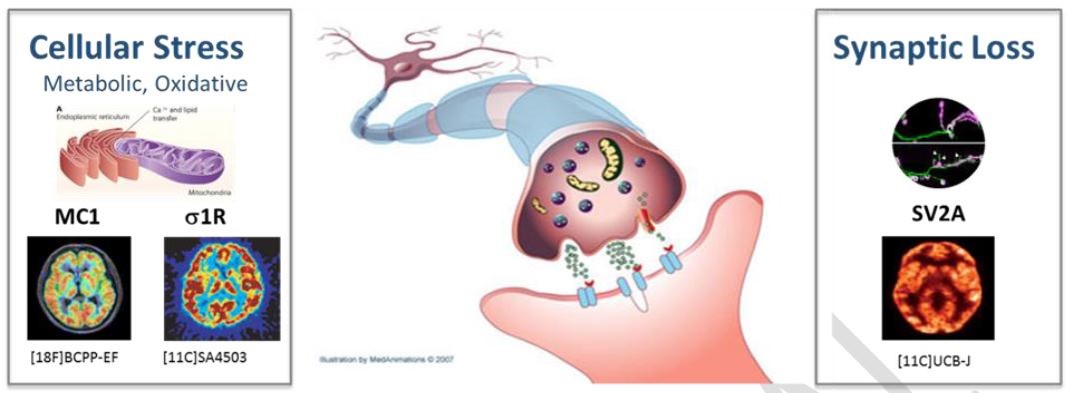In the scope of the MIND MAPS program Invicro UK (formerly Imanova) has recently completed the implementation of three PET ligands to quantify the density of the molecular targets mitochondrial complex-1 (MC1), sigma-1 receptor (σ1R) and synaptic vesicle protein 2A (SV2A) in the living human brain.
MIND-MAPS (Molecular Imaging of Neurodegenerative Disease – Mitochondria, Associated Proteins & Synapses) is a programme designed to evaluate multiple markers of neuropathological changes, in healthy subjects and patients with suspected neurodegeneration and cognitive decline to investigate common pathways of disease.
We believe that the examination of an integrated set of markers will be superior to the examination of a single molecular target to monitor disease progression, and propose, uniquely, to evaluate these 3 molecular targets in each individual in order to quantify the molecular targets of the mitochondrial/ER/synapse axis.
MC1 – is an indicator of Oxidative Stress, a process which damages essential constituents of the cell and accelerates aging. MC1 deficiencies are widely found in the brains of patients with Parkinson’s Disease, indicating a possible link with disease severity.
The novel MC1 ligand, [18F]BCPP-EF , has been well characterised in pre-clinical models of AD and PD by MIND MAPS collaborator, Dr Tsukada, Head of the Hamamatsu PET centre in Japan.
σ1R – is a molecular marker of the mitochondrion-associated endoplasmic reticulum (ER) membrane (MAM). There is growing evidence of disruption of interactions between the ER and MAM in a number of neurodegenerative diseases. An increase in the expression of σ1R is an indicator of Metabolic Stress.
[11C]SA4503 is the best established PET ligand for the quantification of σ1R availability in the human brain in vivo (Sakata, Kimura et al. 2007).
Synaptic vesicle protein 2A (SV2A) is a membrane glycoprotein expressed exclusively in neurons and endocrine cells and is present on all synaptic neurotransmitter vesicles where it is essential for normal neurotransmission. Neurodegenerative disease is characterised by loss of neurons, which typically occurs as a consequence of synaptic/axonal die-back. Extensive literature exists detailing the utility of SV2 as molecular marker to monitor synaptic loss in neurodegenerative conditions, highlighting the value of a specific and selective PET ligand for this target as an indicator of synaptic loss.
[11C]UCB-J, a marker for SV2A, has been demonstrated to have excellent imaging qualities in the human brain. First human and primate studies by UCB Pharma in collaboration with the Yale PET Center have demonstrated that [11C]UCB-J signal is sensitive to synaptic loss, making it the most exciting development in the direct estimation of synaptic status in the last 20 years.

Although these ligands aren’t new, it is the clinical evaluation of this combination of tracers in patients with neurodegenerative disease that makes the MIND MAPS programme cutting-edge. The initial study will focus on patients with Alzheimer’s disease and Parkinson’s disease. Pending successful completion in these patient groups, the programme will be extended to other neurodegenerative disorders.
Invicro UK has the capability and experience to help identify, evaluate, develop and implement biomarker candidates for use in both preclinical models and clinical (in humans) studies. We developed and implemented over 21 imaging biomarkers to Good Manufacturing Practice (GMP) standard since 2011.
In addition to neurosciences, Invicro UK offers i-Biomarker development for other key therapeutic areas including oncology, inflammation, cardiology and respiratory diseases.
